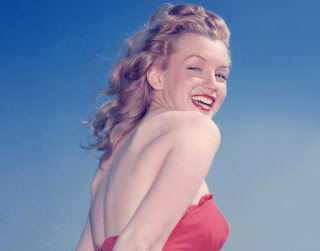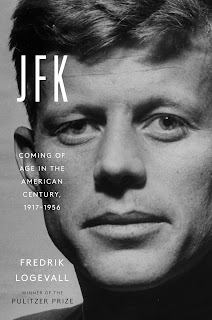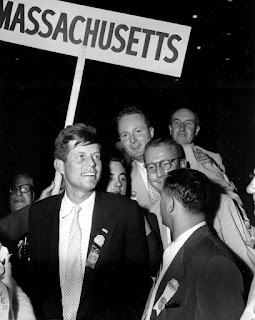
A passionate love affair between Marilyn Monroe and John F. Kennedy has been assumed for so long that it has achieved as solid a place in public awareness as almost any other event in the man’s presidency. All that can be known for certain is that on four occasions between October 1961 and August 1962, the president and the actress met, and that during one of those meetings they telephoned one of Marilyn’s friends from a bedroom; soon after, Marilyn confided this one sexual encounter to her closest confidants, making clear that it was the extent of their involvement. In October 1961, after a photography session for a magazine, Marilyn asked Allan Snyder to deliver her to a party at Patricia and Peter Lawford’s Santa Monica beach house. The occasion was a dinner party honoring President Kennedy, and among the other guests were several blond movie stars—Kim Novak, Janet Leigh and Angie Dickinson, for all of whom the president had a keen appreciation. All contrary allegations notwithstanding, this was the first meeting between Marilyn Monroe and John Kennedy; hearsay about any earlier introduction simply cannot be substantiated. The schedules of Monroe and Kennedy since his January 1961 inauguration reveal wide geographic distances between them. That October night, Marilyn was driven back to her apartment by one of the Lawfords’ staff.

The second encounter occurred during February 1962, when Marilyn was again invited to a dinner party for the president, this time at the Manhattan home of Fifi Fell, the wealthy socialite widow of a famous industrialist. She was escorted to the Fell residence by Milton Ebbins. The third meeting occurred on Saturday, March 24, 1962, when both the president and Marilyn were houseguests of Bing Crosby in Palm Springs. On that occasion, she telephoned Ralph Roberts from the bedroom she was sharing with Kennedy. “She asked me about the solus muscle,” according to Roberts, “which she knew something about from the book The Thinking Body, and she had obviously been talking about this with the president, who was known to have all sorts of ailments, muscle and back trouble.” That night in March was the only time of her “affair” with JFK. “A great many people thought, after that weekend, that there was more to it. But Marilyn gave me the impression that it was not a major event for either of them: it happened once, that weekend, and that was that,” said Roberts. Accounts of a more enduring affair with John Kennedy, stretching anywhere from a year to a decade, owe to fanciful supermarket journalists and tales told by those eager for quick cash or quicker notoriety: those who fail to check the facts of history and are thus easily dispatched as reliable sources.

“Marilyn liked President Kennedy, the man as well as the office,” according to Sidney Skolsky, among the first friends to be informed of the March tryst; he added that she also enjoyed the fantasy that this experience carried—“the little orphan waif indulging in free love with the leader of the free world.” And as she soon after told Earl Wilson, Rupert Allan and Ralph Roberts, she found John Kennedy amusing, pleasant, interesting and enjoyable company, not to say immensely flattering. As for Mrs. Kennedy, as Skolsky added, “Marilyn did not regard her with envy or animosity.” The exaggeration of his “affair” with Marilyn is part of the myth of King Arthur’s Camelot. There was a need to believe in the tradition of courtly intrigues and infidelities—Lancelot and Guinevere, Charles II and Nell Gwynn, Edward VII and Lily Langtry. But in this case there was but one rendezvous between the attractive, princely president and the reigning movie queen; to follow the Arthurian simile: the mists of Avalon are easily dispersed by shining reality’s clear light onto the scene. It is important to establish definitively the truth of this matter not only for the sake of historical accuracy but also because of a far more damaging rumor that began after Marilyn Monroe’s death.

The unfounded and scurrilous accounts of a concomitant or subsequent sexual affair with Robert F. Kennedy, has been even more persistent than that of the presidential liaison. It has also led to the completely groundless assertion of a link between Robert Kennedy and Marilyn’s death—a connection so outrageous as to be hilarious were it not also injurious to the man’s reputation. The rumors of an affair with Robert Kennedy are based on the simple fact that he met Marilyn Monroe four times, as their schedules during 1961 and 1962 reveal, complementing the testimony of Edwin Guthman, Kennedy’s closest associate during this time. But Robert Kennedy probably never shared a bed with Marilyn Monroe. Guthman, a Pulitzer Prize–winning investigative reporter and journalist, was Special Assistant for Public Information in the Kennedy administration as well as senior press officer for the Justice Department. The travel logs of the attorney general’s schedule for 1961–62 (preserved in the John F. Kennedy Library and in the National Archives) support the detailed accounts provided by Guthman. These, collectively, attest to the fact that Robert Kennedy and Marilyn Monroe enjoyed a socially polite relationship—four meetings and several phone calls over a period of less than ten months. But their respective whereabouts during this time made anything else impossible—even had they both been inclined to a dalliance, which is itself far from the truth on both counts.

Marilyn’s first meeting with Robert Kennedy occurred several weeks before her introduction to the president. “On either October 2 or 3, 1961,” said Guthman: “Kennedy and I were attending a series of meetings with United States attorneys and members of the FBI in Albuquerque, Phoenix, Los Angeles, San Francisco, Portland and Seattle. The attorney general and I attended a dinner party at the Lawfords, and around midnight Marilyn decided to go home. But she had drunk too much champagne, and we were worried for her. Bobby and I would not let her drive her car, and we did so together, delivering her safely to her door.” The second meeting between the attorney general and Marilyn occurred on Wednesday evening, February 1, 1962, when he and his entourage dined at the Lawfords en route from Washington to the Far East on a diplomatic journey. “That evening,” according to Guthman, “Marilyn was quite sober—a terrifically nice person, really—fun to talk with, warm and interested in serious issues.” Pat Newcomb, also present at the dinner, remembered that Marilyn really cared about learning. The day before [the dinner party], Marilyn told me, “I want to be in touch, Pat—I want to really know what’s going on in the country. She was especially concerned about civil rights. She had a list of questions prepared. When the press reported that Bobby was talking to her more than anyone else, that’s what they meant. I saw the questions and I knew what they were talking about. She identified with all the people who were denied civil rights.” —Marilyn Monroe: The Biography (2014) by Donald Spoto

Madonna has finally confirmed that the mystery project she's been writing throughout quarantine with Oscar-winning Juno scribe Diablo Cody is in fact a movie about her life. In a Thursday evening Instagram Live session, the pop icon revealed extensive details about the film's plot, describing its focus as a tale of the making of a superstar. The 62-year-old confirmed the pair have so far written 107 pages of the script, which they said will likely end up with a two-hour runtime. "We do talk about Andy Warhol, Keith Haring, Jean-Michel Basquiat and Martin Burgoyne and the whole coming up as an artist in Manhattan, downtown, Lower East Side in the early '80s," Madonna said of the project. "Honestly, it's one of the best times of my life, and one of the worst times. I hope I can portray or express what a thrilling time that was for me in every way." It appears Cody's signature wit and signature comedic edge will make their way into the movie, given that Madonna describes Warhol's dialogue as "monosyllabic". The currently untitled movie is set to feature scenes about the creations of some of Madonna's most memorable works like True Blue, Material Girl (inspired by Marilyn), including a "great scene of me writing Like a Prayer with Pat Leonard," and her devastating experience with Pepsi, referencing the soft drink company infamously severing its sponsorship contract with the superstar after intense social backlash over the 1989 single.

Over the years, fans have speculated as to who could potentially play the singer-songwriter in an eventual biopic, and in recent weeks their focus turned to Ozark actress Julia Garner (Emmy Award winner) after it was discovered that both Madonna and her manager, Guy Oseary, had followed the 26-year-old on Instagram. In her Instagram video Madonna begins by joking, 'I'm writing a different script.' Cody, 42, laughs at this and says, 'What if you're writing someone else's life story, while I write yours?'
Source: ew.com

At a newsstand, JFK Jr. looked at the latest edition of Vanity Fair with a provocatively blonde Madonna on the cover. Inside she had posed for a photoshoot as part of an “Homage to Norma Jean/Marilyn” pin-up layout. JFK Jr. and Madonna were seen working out together at a gym called Plus One, in Manhattan’s Soho district, after which they were also spotted jogging together at Central Park. Here was America’s most eligible bachelor, dating the world’s “most glamorous and exciting singer.” However, Madonna had hesitated to pose again as Marilyn for John's magazine George, maybe sensing a looming curse if she did. Ever since the 1940s, Jackie had read Life magazine and the issue that most shocked her was the one featuring Madonna imitating the physicality of Marilyn Monroe. Ted Sorensen said, “It was like Marilyn coming back from the grave to haunt Jackie. Marilyn had an adventure with her husband. Now Madonna was trying to take her son away.” During her son’s affair with Madonna, John didn’t keep her abreast of developments, so Jackie had to read about him in the papers.

“Madonna realized that adding John F. Kennedy Jr.’s scalp to her sexual belt would be another good publicity coup,” said author Wendy Leigh. In his biography of Madonna, Andrew Morton wrote: “Although JFK Jr. and Madonna dated for a brief period, the affair was not a success. John Junior was intimidated by Madonna’s reputation and she was not really his type. His psychology therapist had explained him Madonna represented insurrection for him, not romance, just a way of acting out his rebellious ways against his mother. Rather ruefully, Madonna explained to some friends that John Kennedy Jr was just too nervous in her presence for them to click sexually. The chemistry certainly wasn’t there. ‘Some guys can handle the fame, others can’t,’ she said. “And he couldn’t.” Even if passion wasn’t there, Madonna knew a hunk when she saw one: “He is extraordinarily handsome, and when he looks down at you with those bedroom eyes, you melt.” Author J. Randy Taraborrelli quotes a friend of John who claimed, “I heard from good sources that Madonna did what she could to interest John, but he didn’t take the bait and kept his distance.” According to former law school classmate Christopher Mayer, John had confessed: “I don't want to be alone with her. She scares the hell out of me.” Besides, Madonna was still married to Sean Penn, an estranged husband prone to jealousy. Penn had an arsenal of handguns in the basement of his Malibu villa. At one point he put up a poster of John and fired with bullets from his .357 magnum. He got John right between the eyes.

John F. Kennedy Jr. was considered a perfect specimen of young American manhood. But was he really? Similar to the medical handicaps that had plagued his father JFK, it's not difficult to infer he had inherited some of his health ailments, in his case Graves Disease. Although less serious than JFK's Addison disease, when it flared, it left him depleted of energy for long periods of time. Despite his seemingly social charisma, there were hidden signals of a traumatized youth who was often overly medicated, taking Ritalin for Attention Deficit Disorder when he was a kid and antidepressives (Wellbutrin) in his adult age. It seems that in some respects, his mother Jackie had been his harshest critic, and to some extent his sister Caroline echoed these sentiments. Jackie had called him “an underachiever.” He defended himself by claiming he was dyslexic. Jackie equivocally thought Onassis would leave his son a $15 million trust fund when he passed away. But when the Onassis will was published on June 6, 1975, the Greek magnate had left JFK Jr. only a meagre bequeath of $ 25,000. Jackie had warned her son that if he wanted to be president, “You’ve got to stop dating all those floozies. America likes its First Ladies respectable. Posing nude for Playboy is not the way to go if you want to sit in the Oval Office one day.” He did not want to remind his mother that her own nude pictures taken in Skorpios had been put in circulation in 1972 by Hustler magazine. Jackie Kennedy, in fact, had the dubious honor of being the first First Lady ever featured in a nude centerfold.

Christina Haag dated JFK Jr. since 1985-1989: In the intimacy, John demonstrated me a great deal of masculine energy which made me immediately connect to my feminine energy, and I truly loved it. He demonstrated enough curiosity when I gave him a book about Tantric sex for Christmas. John always was more interested on the romantic side during the relationship, but he seemed to be very fascinated by the possibilities that Tantric tecniques offered us. He always took responsibility for my pleasure first and he was most attentive, with a fondness for lenghty cuddly sessions. John believed his father actually had not been that great of a lover. But he also thought men were supposed to take action and take the lead. Since the beginning, I had realized he would be great husband material someday. Leadership was a quality so important and attractive for me. —Come to the Edge: The Love Story of John Kennedy Jr. and Christina Haag (2011)

During his first semester at Phillips Academy in Andover, John Jr met Sasha Chermayeff, who would become one of his closest friends. He would later refer to her as the “platonic love of my life” and “the coolest, least stuck-up girl I know.” She had attended the prestigious Dalton School while John was at Collegiate, and they had both made the unusual decision to transfer to Andover in the eleventh grade. “It was unusual,” she reflected, “because most people did not go to Andover for only two years.” Since both of them were new to campus, John and Sasha naturally bonded, ending up enrolled in many of the same classes. She described him as “this funny, sweet, loving guy.” “Two weeks into that first semester, we were already quite friendly,” Sasha recalled. “We made out once but we didn't go further.” It was Jackie’s decision to transfer John from Collegiate, where he was performing well with high grades, to a new school in rural Massachusetts. “His mother was very anxious about safety in Manhattan,” recalled Collegiate history teacher Bruce Breimer. “She was afraid he was going to get hurt, that some nut was going to find him.” John had lost his Secret Service protection and he could become an obvious target. Soon Sasha and John engaged in long conversations, and she quickly realized that he was more complicated than he appeared. “John didn’t have a carefree background,” she reflected, “yet he came off like this carefree guy.” About John's interest to study film, “I really think that’s just a myth,” reflected Sasha. “I think he enjoyed acting. But he had no intention of pursuing acting professionally, ever. I never ever heard him say anything seriously about wanting to pursue it as a real life’s work.” She learned from their conversations “that there were big difficulties in his life,” and his problems became “more complex as he got older. It wasn’t easy being John, but he carried his burden with such enormous grace.” On 8 July 1999, Sasha Chermayeff joined her close friend John F. Kennedy Jr. for a dinner in Manhattan. Afterward, as the two walked home through the city streets, Kennedy turned to her and said: “I really want to have a child with Carolyn.” Eight days later Sasha had lost John forever. —The Day John Died (2007) by Christopher Andersen
































































